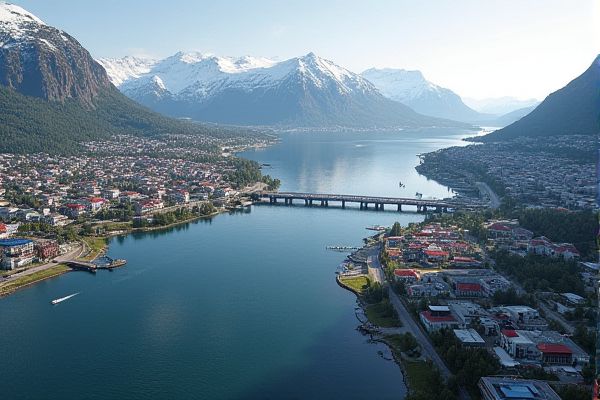
Weather and climate in Norway: Long, cold winters. Short, mild summers. Coastal mildness from Gulf Stream. Frequent snow in winter. Rainy autumn season. Midnight Sun phenomenon. Polar night in northern regions. Arctic climate in Svalbard. Unpredictable mountain weather. Frequent weather changes.
Long, cold winters.
In Northern Norway, winters extend from late October to April, with the harshest cold occurring from December to February. This period is marked by the polar nights, heavy snowfall, icy roads, and sub-zero temperatures, necessitating both physical and mental adjustments to endure the prolonged darkness and cold. Embracing these challenges and learning to thrive in such an environment are essential for residents and visitors alike. To gain more insight into this unique winter experience, visit the article on Daily Scandinavian, which explores the various ways individuals adapt to the formidable conditions of Northern Norway's winter season.
Short, mild summers.
Norway's summers are short and mild, with temperatures typically around 20 degrees Celsius (68°F) in the eastern parts of the country, and cooler along the coasts and in mountainous areas. This climate allows for a variety of outdoor activities despite the relatively cool temperatures. For more information on how to plan your trip and what to expect during different times of the year, visit the official Visit Norway website. Whether you're exploring the serene fjords or hiking through stunning landscapes, Norway's unique climate offers an exceptional experience.
Coastal mildness from Gulf Stream.
The Gulf Stream, or the North Atlantic Current, significantly warms Norway's climate by releasing heat into the atmosphere as it flows irregularly and chaotically along the Norwegian coastline, preventing the waters from passing quickly and thus transferring more heat to the land. This current is crucial in maintaining a much milder climate in Norway compared to other regions at similar latitudes, such as Greenland and Northern Canada. For more information on this fascinating oceanic phenomenon, visit the Science Daily article that delves into the dynamics of the Gulf Stream and its climatic impacts.
Frequent snow in winter.
In Norway, frequent snow in winter is common, especially in inland and mountainous areas, but climate change is leading to a shorter snow season, particularly in low-elevation and coastal regions, where the number of days with snow cover is decreasing. High-mountain areas, however, may experience slight increases in snowfall despite the overall trend of warmer winters and reduced snow cover in most populated areas. For more in depth details, you can visit the Climate of Norway page on Wikipedia.
Rainy autumn season.
Autumn in Norway is characterized by diverse climate conditions, with coastal areas experiencing milder temperatures and interior regions getting chilly. Rain is common, especially in September and October, which are the wettest months, adding to the beauty of the landscape with misty scenes and rainbows. For more detailed travel ideas and seasonal insights, you can visit the Norway In Autumn blog to explore how this vibrant season paints the country in stunning hues of nature's palette.
Midnight Sun phenomenon.
The Midnight Sun in Norway is a remarkable natural phenomenon occurring above the Arctic Circle, where the sun stays above the horizon even at midnight, offering up to 24 hours of daylight from mid-May to mid-July. This breathtaking occurrence becomes more pronounced as you venture further north. For example, areas like Svalbard enjoy constant sunlight from late April to late August. For those interested in experiencing this unique event, visiting the Visit Norway website provides valuable insights and travel tips to make the most of your Midnight Sun adventure in some of the world's northernmost regions.
Polar night in northern regions.
The Polar Night in Northern Norway occurs when the sun remains below the horizon for weeks or months, typically from late November to late January, depending on the latitude. This period, caused by the Earth's axial tilt, brings extended darkness but also unique light displays, such as colorful sunsets and the Northern Lights, despite the absence of direct sunlight.
Arctic climate in Svalbard.
Svalbard has a severe Arctic climate characterized by very cold winters and short, cool summers. The region experiences extreme daylight patterns, including polar night in winter and the midnight sun in summer, with temperatures ranging from as low as -46°C in winter to up to 6°C in summer. It is one of the fastest-warming places on Earth due to Climate Change.
Unpredictable mountain weather.
Norway's mountain weather is highly unpredictable due to the interaction between the warm Gulf Stream and cold Arctic air masses, leading to rapid changes in weather. The mountains act as barriers, causing prevailing winds to rise and cool, resulting in orographic precipitation and significant variations in weather conditions within short distances. For those planning to explore this challenging yet breathtaking region, insights from the Unpredictable Weather in Norway Guide by Campervan Bergen can be invaluable. Whether you're a traveler, hiker, or camper, understanding these dynamics can significantly enhance your experience and safety.
Frequent weather changes.
Norway is known for frequent and varied weather changes, particularly in Fjord Norway, where one can experience rain, sun, wind, and even snow in the same day, reflecting the country's dynamic and unpredictable climate. For more detailed information about the seasons and weather patterns, you can visit the comprehensive guide on the Visit Norway website.
